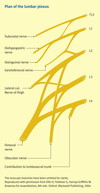11. Abdomen V Flashcards
(184 cards)
What is the abdomenal course of the ureters?
1) Crosses over PSOAS major
2) Crosses over genitofemoral nerves (part of lumbar plexus, easy to identify as it always crosses over PSOAS major muscle)
3) Gets crossed obliquely by gonadal vessels (e.g. ovararian or testicular arteries)
4) Crosses the bifurcation of common iliac artery (L4/L5) to enter pelvis
What shape is the right suprarenal gland?
Pyramid
What shape is the left suprarenal gland?
Crescent
What is the nervous innervation of the kidneys?
Sympathetic:
Has vasomotor roles, regulating blood flow and renin secretion
It is from the renal plexus which follows the renal arteries
Post-ganglionic sympathetic from T10-L1
Parasympathetic:
This is contested as some texts state that parasympathetic fibres branch from vagus nerve however others say that there is no evidence of parasympathetic innervation of the kidneys.
Regardless, renal function is not dependent on innervation as is shown by renal transplants where the kidneys work just fine without being innervated.
Renal function is regulation ‘by’ hormones.
What is the arterial ‘supply’ of the kidneys
Renal arteries, which divied into five segmental arteries (4 anterior and 1 posterior)
These then divide to lobar arteries, then interlobar arteries, arcuate artereis and then interlobular arteries
What are some characteristics about suprarenal glands?
- Endocrine glands
- present on upper/superior pole of kidneys
- the right suprarenal gland is pyramidal whereas the left suprarenal gland is crescent-shaped
- Suprarenal glands are surrounded by renal fascia, hence even if kidney is disturbed the suprarenal glands are shielded
- They contain a yellow cortex and a brown medulla

What is the yellow cortex of the suprarenal glands derived from?
Mesoderm
What is the brown medulla of suprarenal glands derived from?
Neural Crest
What is the function of the yellow cortex of the suprarenal glands?
Secretes androgens and corticosterioids
What is the function of the brown medulla of the suprarenal glands?
Secrete catecholamines (adrenaline and noradrenaline)
What are the three main arteries of the suprarenal glands and where do they branch from?
- Superior suprarenal artery - branch from the inferior phrenic artery
- Middle suprarenal artery - comes off aorta directly
- Inferior suprarenal artery - comes off renal artery

Where does the right suprarenal vein drain into?
IVC
Where does the left suprarenal vein drain into?
Left renal vein (more efficient than traversing aorta to get to IVC)
List some functions of the kidneys
- Acid-Base balance
- Excretes most waste products of metabolism
- Water and electrolyte balance of the body
- Secretes hormones and renin into the bloodstream
Kidneys filter around 113-114 pints of blood per hour
Filters all the blood in the body around 400 times a day
blood flow to the kidney is greater than to the heart
Are kidenys primary or secondary retroperitoneal?
Primary retroperitoneal
Which kidney is lower than the other and why?
Right is lower due to the presence of the liver above it (pushing it downwards)
What is the vertebral position of the kidneys?
Located between T12 and L3

What is the vertebral level of the hila of the kidneys?
L1

Which ribs surround the kidneys?
Ribs 11 and 12
Why do ribs move upon inspiration?
Because they are closely associated with the diaphragm
What are the anterior relations of the right kidney
- Superior pole - right suprarenal gland/adrenal gland (pyramid shape)
- Liver - anterior surface of kidney ‘in contact’ with liver, but separated by peritoneum (hepatorenal pouch of morison)
- Descending duodenum - close contact with hilum of right kidney
- Right colic flexure - in contact with lower lateral part of kidney
- Small intestine - lower medial side of kidney, separated by peritoneum
The surfaces of the kidney in contact with the liver and the small intestines are the surfaces which are ‘covered’ in periotoneum

What are the anterior relations of the left kidney?
- Superior pole - left suprarenal gland/adranl gland (crescent shape)
- Stomach - separated by perionteum
- Spleen - separated by peritoneium (lienorenal/ splenorenal ligament)
- Pancreas - middle part of kidney
- Left colic flexure - lateral middle part of kidney
- descending colon - inferior middle part of the kidney
- Jejunum - lower medial part of kidney, separated by pertoneium
Thus, surfaces in contact with the stomach, spleen, and jejunum have periteonum ‘covering’ it

What are the posterior relations of the kidneys?

Posteriorly, kidneys are closely associated with the muscles of the posterior abdomenal wall:
- Superior pole is closely associated with the diaphragm
- Medially kidneys are closely associated with the PSOAS minor/major muscle
- ‘Middle laterally’ kidneys are closely associated with quadratus lumborum muscle
- Laterally the kidneys are closely associated with the trasversus abdominus muscle

Label this image









































